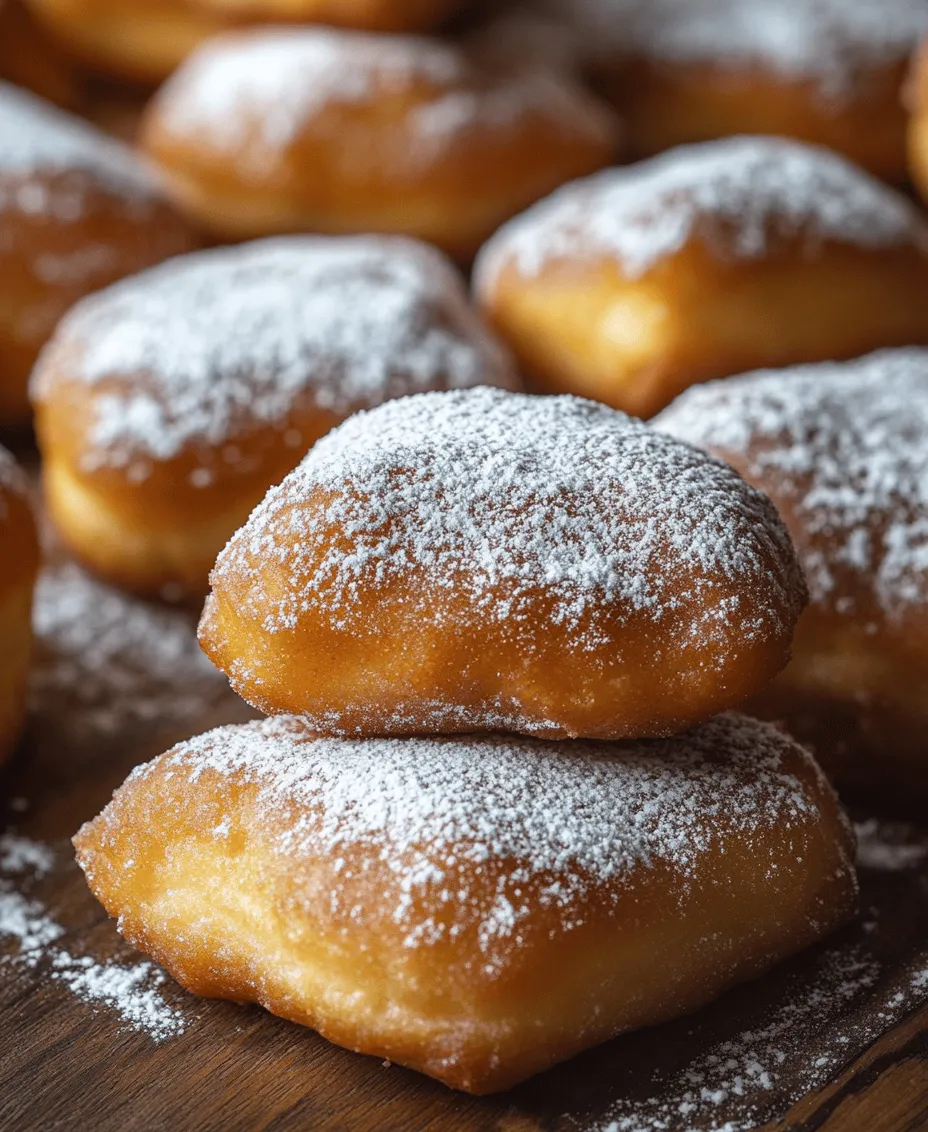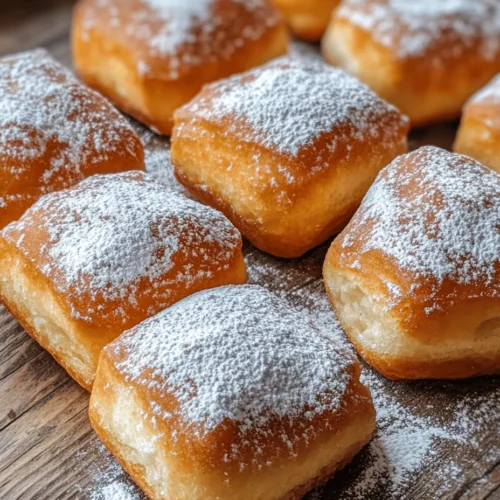Introduction
If you’ve ever wandered the streets of New Orleans, the sweet aroma of freshly fried pastries wafting through the air would have undoubtedly drawn you in. Among these delectable treats are beignets, the iconic French doughnuts that have won the hearts of many with their soft, fluffy texture and delightful sweetness. Beignets are more than just delicious pastries; they carry a rich cultural significance, reflecting the fusion of French and Creole culinary traditions. They are a staple of New Orleans cuisine, often enjoyed with a cup of coffee and powdered sugar dusting—a quintessential experience that evokes the charm and vibrancy of the city.
In this article, we will delve into the world of Vanilla French Beignets, a simple yet indulgent recipe perfect for sweet treat lovers. These beignets are easy to make at home, allowing you to recreate the magic of this beloved pastry without needing to travel. The joy of whipping up a batch of fluffy, golden beignets from scratch is unparalleled; there’s something immensely satisfying about watching them puff up in hot oil, transforming into airy pillows of goodness. With a hint of vanilla and a dusting of powdered sugar, these beignets are sure to impress your family and friends.
The History of Beignets
To fully appreciate Vanilla French Beignets, it’s essential to understand their origins. Beignets trace their roots back to France, where the term “beignet” simply means “fried dough.” They are believed to have been introduced to America by French settlers in the 18th century. Initially, they were made with a simple dough, and as culinary techniques evolved, so did the recipes. Today, they are commonly associated with sweet fillings and are often served warm, coated generously with powdered sugar.
The beignet’s journey took a significant turn in New Orleans, where they became a beloved treat synonymous with the city’s vibrant culture. New Orleans-style beignets are typically square-shaped and served hot, often accompanied by café au lait. Their popularity soared during Mardi Gras celebrations, where they symbolize indulgence and festivity. Whether enjoyed as a breakfast treat or a dessert, beignets have become a cultural icon, representing the lively spirit of New Orleans.
Globally, beignets have inspired variations in different cultures, such as the Italian zeppole, the Spanish churro, and the Portuguese malasadas. Each of these treats shares the common theme of fried dough but comes with distinct flavors and textures that reflect their cultural origins. The versatility of beignets showcases their universal appeal, making them a cherished delight across the globe.
Understanding the Ingredients
Creating perfect Vanilla French Beignets requires a keen understanding of the ingredients involved. Each component plays a crucial role in achieving the desired texture and flavor. Here’s a detailed breakdown of the key ingredients used in this delightful recipe:
– All-Purpose Flour: This is the foundation of the beignet dough. All-purpose flour provides the necessary structure, allowing the beignets to hold their shape while frying. It also contributes to the overall texture, ensuring the beignets are light and fluffy.
– Granulated Sugar: A touch of sweetness is essential for any dessert, and granulated sugar enhances the flavor of the dough. It also contributes to the browning process during frying, resulting in beautifully golden beignets.
– Baking Powder: This chemical leavening agent is crucial for creating the fluffiness that characterizes a perfect beignet. When combined with moisture and heat, baking powder releases carbon dioxide, causing the dough to rise and become airy.
– Milk: Milk adds moisture and richness to the dough, creating a tender texture. It also helps to activate the baking powder, contributing to the beignets’ lightness.
– Eggs: Eggs play a dual role in this recipe. They bind the ingredients together and enrich the dough, lending a richness that enhances the overall flavor and texture of the beignets.
– Unsalted Butter: Incorporating unsalted butter into the dough enhances the flavor and tenderness of the beignets. The fat in the butter contributes to a moist interior and a slight crispness on the outside.
– Vanilla Extract: The star flavor of this recipe, vanilla extract, infuses the beignets with a warm, aromatic essence. It elevates the overall sweetness and creates a comforting flavor profile that pairs beautifully with the fried dough.
– Vegetable Oil: For frying, vegetable oil is the preferred choice due to its high smoke point. It ensures that the beignets fry evenly and achieve the perfect crispiness without absorbing too much oil.
– Powdered Sugar: The final touch for presentation and sweetness, powdered sugar is generously dusted over the beignets just before serving. It adds a touch of elegance and enhances the overall experience of enjoying these delightful pastries.
Step-by-Step Guide to Making Vanilla French Beignets
Before diving into the recipe, it’s important to gather all necessary equipment and prepare your workspace. Here’s what you’ll need to get started:
Equipment Needed
– Mixing bowls
– Whisk
– Rolling pin
– Knife or pizza cutter
– Frying pan or deep fryer
– Slotted spoon
– Paper towels
– Cooling rack
With everything in place, let’s get started on the step-by-step process for making Vanilla French Beignets:
Step 1: Prepare the Dough
1. In a large mixing bowl, combine 2 cups of all-purpose flour, ¼ cup of granulated sugar, and 1 tablespoon of baking powder. Whisk the dry ingredients together until well blended.
2. In a separate bowl, whisk together ½ cup of milk, 2 large eggs, 2 tablespoons of melted unsalted butter, and 1 teaspoon of vanilla extract. Ensure the ingredients are thoroughly mixed.
3. Gradually pour the wet ingredients into the dry mixture, stirring gently until a soft dough forms. Be careful not to overmix; it’s okay if the dough is slightly sticky.
Step 2: Roll Out the Dough
1. Lightly flour your work surface to prevent sticking. Turn the dough out onto the floured surface and gently knead it for about 30 seconds until it becomes smooth.
2. Using a rolling pin, roll the dough out to approximately ½-inch thickness. Ensure that the dough maintains an even thickness for uniform frying.
3. Using a knife or pizza cutter, cut the dough into squares or rectangles, about 2 inches in size. You can make them larger or smaller depending on your preference.
Step 3: Heat the Oil
1. In a deep frying pan or deep fryer, heat about 2 inches of vegetable oil over medium heat. To test if the oil is ready, drop a small piece of dough into the oil; if it sizzles and rises to the surface, the oil is hot enough for frying.
Step 4: Fry the Beignets
1. Carefully drop a few pieces of dough into the hot oil, ensuring not to overcrowd the pan. Fry the beignets for about 2-3 minutes on each side, or until they are golden brown.
2. Using a slotted spoon, remove the beignets from the oil and transfer them to a paper towel-lined plate to drain excess oil.
3. While the beignets are still warm, dust them generously with powdered sugar for that classic beignet finish.
Stay tuned for the continuation of this delectable recipe, where we will explore additional tips for achieving the best results and answer common questions about making Vanilla French Beignets.

Mixing Dry Ingredients Effectively
To create the perfect Vanilla French Beignets, it is essential to start with a solid foundation by mixing your dry ingredients correctly. Begin by combining all-purpose flour, baking powder, granulated sugar, and a pinch of salt in a large mixing bowl. Whisk these dry ingredients together thoroughly to ensure even distribution. This step is crucial as it prevents clumping, allowing the baking powder to activate uniformly throughout the dough. A well-mixed dry base will lead to fluffy and light beignets, which is what we aim for.
Combining Wet Ingredients and Understanding Consistency
Once your dry ingredients are ready, it’s time to focus on the wet ingredients. In a separate bowl, whisk together eggs, whole milk, melted butter, and vanilla extract until smooth. The addition of vanilla is what gives these beignets their signature flavor, so don’t skimp on quality—pure vanilla extract is recommended for the best results.
When combining the wet ingredients with the dry mixture, pour the wet mixture gradually into the bowl of dry ingredients, stirring gently with a spatula or wooden spoon. Be cautious not to overmix; the goal is to combine until just incorporated. The dough should be thick but still slightly sticky. If it appears too dry or crumbly, add a little more milk, one tablespoon at a time, until you reach the desired consistency. A well-balanced dough is critical for achieving that soft, airy texture that makes beignets so delightful.
Tips for Rolling Out Dough to the Right Thickness
Once the dough is ready, it’s time to roll it out. Place the dough on a lightly floured surface to prevent sticking. Using a rolling pin, gently roll the dough into a rectangle that is about ½ inch thick. This thickness is ideal, as it allows the beignets to puff up nicely during frying without becoming too dense.
To ensure even rolling, start from the center and work your way out to the edges, turning the dough frequently to maintain its shape. If the dough starts to stick, sprinkle a little more flour as needed. Remember, the goal is to keep the dough soft and pliable, so avoid excessive flouring that can dry it out.
Cutting Shapes for Even Frying and Presentation
Now that your dough is rolled out, it’s time to cut it into shapes. Traditional beignets are square or rectangular, but you can cut them into any shape you prefer. Use a sharp knife or a pizza cutter to slice the dough into 2-inch squares. Make sure each piece is uniform in size for even frying, as this will help prevent some from cooking faster than others.
Once cut, let the dough squares rest for about 10-15 minutes. This resting period allows the gluten to relax, which will yield a more tender beignet once fried.
Importance of Oil Temperature for Optimal Frying Results
Frying is where the magic happens, and oil temperature is key to achieving perfectly cooked beignets. Use a deep-fryer or a heavy-bottomed pot filled with about 3 inches of oil. Heat the oil to 350°F (175°C). To check if your oil is ready, drop a small piece of dough into the oil; if it bubbles vigorously and rises to the surface, your oil is at the right temperature.
Frying at the correct temperature ensures that the beignets cook evenly, creating a crispy exterior while keeping the inside soft and fluffy. If the oil is too hot, the outside will cook too quickly, leaving the inside raw. Conversely, if the oil is not hot enough, the beignets will absorb too much oil and become greasy.
How to Achieve Golden Brown Beignets and the Significance of Draining Excess Oil
Once the oil is ready, carefully drop the dough pieces into the hot oil, making sure not to overcrowd the pot. Fry in batches if necessary. Cook the beignets for about 2-3 minutes on each side or until they turn a beautiful golden brown. Use a slotted spoon to flip them gently, ensuring they cook evenly.
After frying, it’s crucial to drain the beignets properly. Remove them from the oil and place them on a plate lined with paper towels. This step is vital as it absorbs excess oil, preventing the beignets from becoming too greasy. Allow them to cool slightly before dusting with powdered sugar.
Techniques for Dusting with Powdered Sugar for an Appealing Finish
The final touch to your Vanilla French Beignets is the dusting of powdered sugar. To achieve an even coating, place the powdered sugar in a sifter or fine mesh strainer. Lightly tap the sides to dust the beignets with a fine layer of sugar, ensuring all sides are covered. This not only enhances the beignets’ visual appeal but also adds a delightful sweetness that complements the rich vanilla flavor.
For an extra touch, consider serving the beignets in a beautiful basket lined with parchment paper, generously dusted with powdered sugar on top for presentation. This simple yet elegant finish makes them perfect for any occasion.
Common Mistakes to Avoid
As with any recipe, there are common pitfalls to watch out for when making Vanilla French Beignets. Here are some frequent mistakes and how to avoid them:
1. Overmixing the Dough: Mixing the dough too much can lead to tough beignets. Remember to mix until just combined for a tender texture.
2. Incorrect Oil Temperature: Frying in oil that is too hot or too cold can ruin your beignets. Use a thermometer to ensure the oil is at the correct temperature.
3. Not Letting the Dough Rest: Skipping the resting time can result in denser beignets. Allowing the dough to rest is crucial for achieving that light, airy texture.
4. Unevenly Cut Shapes: Cutting the dough into uneven sizes will lead to inconsistent frying. Aim for uniform pieces for even cooking.
5. Not Draining Properly: Failing to drain excess oil can lead to greasy beignets. Always place them on paper towels immediately after frying.
Solutions to Achieve the Perfect Texture and Flavor
If you encounter difficulties, here are some solutions to common issues:
– Dough Stickiness: If your dough is overly sticky, incorporate a little more flour while kneading. Just be cautious not to add too much, which can dry out the dough.
– Uneven Frying: If some beignets cook faster than others, adjust the heat and ensure you are not overcrowding the pot. Fry in smaller batches for better control.
Tips for Troubleshooting Issues Such as Dough Stickiness or Uneven Frying
– If your dough is sticky, try chilling it for 30 minutes before rolling it out. This can make it easier to handle.
– For uneven frying, always monitor the oil temperature closely and adjust the burner as necessary to maintain a consistent heat level.
Serving Suggestions and Pairings
Vanilla French Beignets are incredibly versatile and can be served in various delightful ways:
Pairing with Coffee or Tea: These beignets make a perfect companion to a cup of coffee or tea. The sweetness of the beignets complements the bitterness of coffee beautifully.
Adding Fruit Preserves or Sauces: Consider serving your beignets with fruit preserves, chocolate sauce, or caramel for an extra flavor boost. A dollop of raspberry jam or a drizzle of chocolate sauce can elevate the experience.
Creative Presentation Ideas: For special occasions or gatherings, serve your beignets in a tiered cake stand or sprinkle with fresh berries for a pop of color. This not only makes for an appealing display but also adds a fresh element to your dessert.
Suggestions for Variations on the Classic Recipe
To keep things exciting, you can experiment with variations of the classic recipe:
– Adding Chocolate Chips or Nuts: Incorporate chocolate chips, chopped nuts, or even dried fruit into the dough for added texture and flavor.
– Infusing Different Flavors into the Batter: Try infusing the batter with different flavors, such as almond extract, coconut, or citrus zest for a unique twist on the traditional beignet.
Conclusion
Making Vanilla French Beignets is not just about creating a delicious treat; it’s about the joy of cooking and the wonderful memories associated with sharing homemade goodies. The satisfaction derived from crafting these fluffy, golden delights in your kitchen is unparalleled. As you enjoy the fruits of your labor, remember that these beignets can be a canvas for your creativity. So don’t be afraid to experiment and make this recipe your own. Whether enjoyed with coffee, shared at a gathering, or savored as a special treat, these beignets are sure to become a beloved favorite in your culinary repertoire. Happy cooking!


